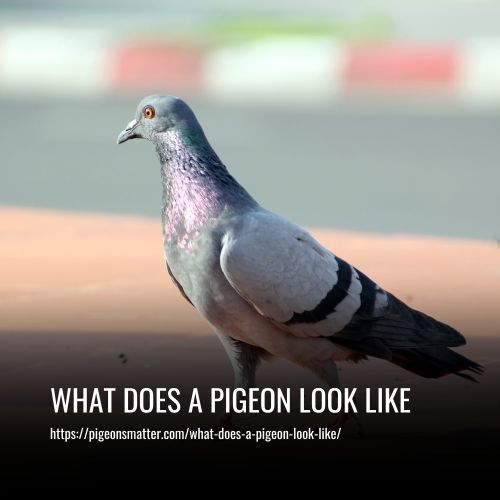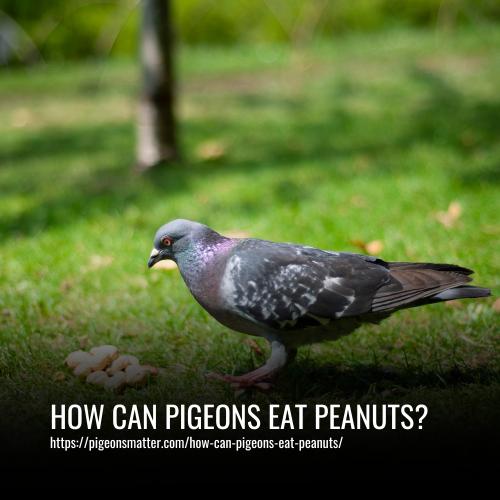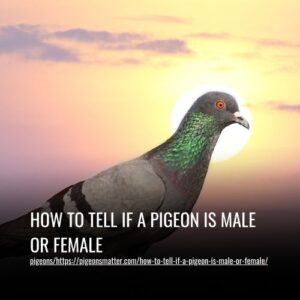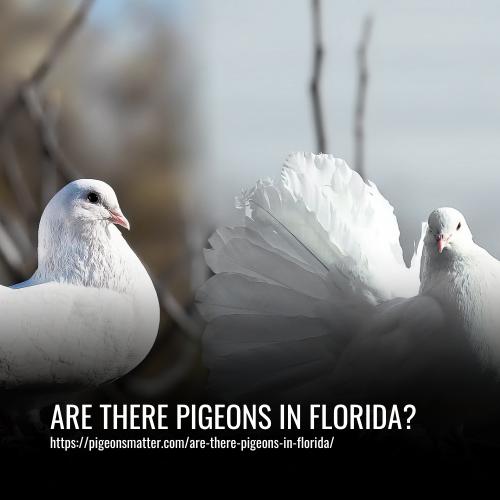Pigeons are large birds with small heads and short legs. They are typically gray-blue in color and have iridescent feathers around their necks and chests. Most pigeons have two dark bands on their wings and another band across their tail feathers. Pigeons are often mistaken for mourning doves, which are smaller and have long, pointed tails. Pigeons are a common sight in urban and suburban areas.

Pigeon Anatomy
Pigeons, also known as doves or rock pigeons, belong to the species Columba livia. They are commonly found in coastal areas and areas of human habitation. Pigeons have a wingspan of 64-72 cm and are approximately 32-37 cm long. Their heads, necks, and chests are dark bluish-grey in color with glossy greenish and reddish-purple iridescence around the neck and wing feathers.
Pigeons have orange or red irises with a pale inner ring in adults, while juveniles have brown or greyish-brown irises. They have a black bill with an off-white cere and red feet and legs. Pigeons also have distinctive twin black wing bars and white lower back feathers.
There are 315 different species of pigeons in the Columbidae family, with 350 recorded varieties. The most common variety is the feral pigeon, with a population of 10-15 million in Europe. Pigeons are distributed worldwide, except for the Sahara Desert, Antarctica, and the high Arctic. The European population is estimated to be between 17 and 28 million birds.
What Does A Baby Pigeon Look Like When It’s Born
Newly-born baby pigeons are easily identifiable by their distinct characteristics. They are completely bald and have a pink color. They are also blind at birth. Their bodies are covered in soft, downy feathers that provide insulation and warmth.
These feathers start off gray or white but quickly turn brown as the baby pigeon grows. Baby pigeons are typically about the size of a golf ball and are incapable of flying or taking care of themselves. They rely heavily on their parents for care and nourishment during this early stage of life.
Are Pigeons All Over the World the Same
While rock pigeons are a common sight in many cities around the world, they are just one of the 351 recognized pigeon species worldwide. These species can be found in various habitats and regions across the globe.
It’s fascinating to think about the diversity of these birds and the unique characteristics that make each species distinct. As bird enthusiasts, we can appreciate and admire the beauty and complexity of these creatures, no matter where we find them.
What Kinds of Pigeons Are Most Common in the World
The following table displays the 10 most frequently occurring pigeon species and their respective locations.
| Type of Pigeon | Where the Pigeon Lives | |
| 1 | Rock dove | Lives worldwide |
| 2 | Hill pigeon | Lives in China, the Himalayas, and Central Asia |
| 3 | Snow pigeon | Lives in Altay, Tian Shan, the Himalayas, and Central China |
| 4 | Speckled pigeon | Lives in Sub-Saharan Africa |
| 5 | White-collared Pigeon | Lives in Eritrea and Ethiopia |
| 6 | Stock dove | Lives in Europe and Central Asia |
| 7 | Yellow-eyed pigeon | Lives in Central Asia and Western China |
| 8 | Somali pigeon | Lives in Northeastern Somalia |
| 9 | Common wood pigeon | Lives from Europe to China |
| 10 | Trocaz pigeon | Lives in Madeira, Portugal |
1. Domestic Pigeons
Domestic pigeons raised for sport, hobby, and food cannot survive in the wild like their wild counterparts. When accidentally or intentionally released, they often require rescue and care. Palomacy frequently takes in these domestic pigeons in need of assistance.
2. King Pigeons
King Pigeons are a breed of pigeon that is primarily bred for food. They are larger than feral and homing pigeons and have pure white feathers and pink beaks. Unfortunately, well-meaning individuals sometimes purchase and release King Pigeons to save them from live animal markets.
However, these pigeons are not equipped with the necessary skills to survive in the wild and face certain death. Instead, King Pigeons make great pets and aviary residents. They are tame and are used to human contact.
If you are interested in keeping a King Pigeon, it’s important to provide them with a safe and comfortable environment where it can thrive.
3. Racing and Homing Pigeons
Homing pigeons are versatile birds that come in a variety of colors but are most commonly blue or white. They are used for racing, weddings, events, and as pets. These birds are strong flyers with exceptional homing instincts and can be trained to return to their lofts after a race or event.
However, they can get lost or injured, and their ownership can often be traced by the information on their band. In some cases, lost homing pigeons may assimilate into wild flocks, and you may spot a banded pigeon foraging with its wild counterparts.
4. Fancy Pigeons
Fancy Pigeons are a popular hobby among pigeon fanciers and pet owners alike. These specialized breeds come in many different varieties, including Pouters, Tumblers, and Owls.
Pigeon fanciers often compete with their birds in competitions, similar to dog shows, to showcase their unique and beautiful breeds.
For those who keep fancy pigeons as pets, they offer a beautiful and interesting addition to any home. The gallery below displays just a few examples of the many different breeds of fancy pigeons available.
5. Feral Pigeons
Feral Rock Pigeons, commonly found in urban and suburban areas, are well adapted to city and rural environments. They are the blue variety of pigeons that roost on buildings and forage for food in public plazas. In the countryside, they often roost in barns or around bridges and natural cliff areas.
Feral pigeons are known to cross-breed with domestic pigeons, passing on color and plumage variations down through generations. However, it’s important to note that wild pigeons should generally be left alone to live as wild birds unless you find an injured feral pigeon or orphaned baby pigeons.
6. Band-Tailed Pigeons
Band-tailed Pigeons are a unique species of wild pigeon that is native to North America and the Pacific Coast. They are easily recognizable by their long, gray banded tail, white band, and iridescent patch at the nape of their neck. These pigeons are typically 14 to 18 inches in length, with a bright yellow beak and feet.
Unlike Rock Pigeons, Band-tailed Pigeons do not display a wide range of color variations. They inhabit forest edges and woodlands, both coniferous and deciduous, and spend much of their time in trees. Acorns are one of their preferred foods, but they also forage for berries, grains, mast-producing plants, and other available resources, depending on the habitat and time of year.
FAQs
Pigeon eggs are small and white in color. They are approximately 38.4 mm in length and 28.6 mm in breadth. The average weight of a pigeon egg is around 14.6g, and the eggshells are about 0.18mm thick.
Baby pigeons are rarely seen because they stay in their nests for about 30 days, which is longer than other bird species. When they leave the nest, they already resemble adult pigeons, so it can be difficult to distinguish them.
A baby pigeon, or a pigeon chick, typically measures about 5 cm in length when it is newly hatched.
A baby pigeon typically weighs about 15g when it is freshly hatched. By the time it reaches 30 days old, its weight can range between 270 and 350 grams, with a daily weight gain of 4 to 8 grams.
Some pigeons have distinct markings such as bars or bands on their wings, iridescent neck feathers, or a small white patch on their necks. These markings can vary depending on the species and individual pigeon.
No, pigeons can come in a variety of colors, with the most common being gray or blue-gray. Other colors include white, brown, black, and even combinations of these colors.
Conclusion
While pigeons may seem like ordinary birds, they are actually quite unique and fascinating creatures. From their distinctive coloring and patterns to their impressive flying abilities, there’s more to these birds than meets the eye.
Next time you see a pigeon, take a moment to appreciate all the amazing qualities that make them such a special part of our natural world.


